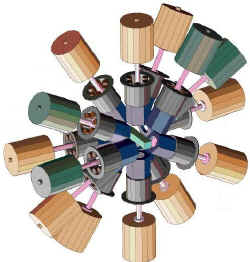The Incredible Shrinking Nucleus

Objects in nucleus may be smaller than they appear. At least, that’s what a paper in the 5 March PRL suggests. The authors measured the decay of a lithium isotope that had at its core a lambda particle–a neutron with one of its two down quarks replaced by a strange quark–and found that the nucleus had shrunk. The lambda particle travels to the center of the nucleus and acts to bind it more tightly together. This experiment is one of the first to give physicists a look at interactions of such strange nucleons inside the nucleus.
In 1983 theorists predicted that the presence of a lambda particle inside a lithium nucleus could cause it to shrink. Since a lambda is neither a proton nor a neutron, it is not constrained by the Pauli exclusion principle, which prevents identical nucleons from occupying the same space and defines the size of the nucleus. This property allows the lambda to take up no space and to slide into the center of a nucleus, where its strong binding energy pulls the other nucleons closer together. But for almost twenty years, there was no experiment that could confirm this prediction.
Now a collaboration led by Kiyoshi Tanida of Tokyo University has found evidence that nuclear shrinkage does exist. The team fired pions into a target of lithium to produce lithium-lambda nuclei. They found the lifetime of these excited nuclei by measuring the spectrum of gamma rays emitted when the lithium-lambdas decayed to their ground state. “The lifetime is very sensitive to the size of the nucleus,” Tanida explains, so it led directly to a size estimate.
This experiment was challenging because it required an extremely accurate measurement of the gamma rays, which were emitted in every direction from the target. The team used an instrument called Hyperball, which consists of 14 high-resolution germanium detectors positioned in a spherical arrangement. Hyperball is one of a handful of such sensitive spherical detector arrays world-wide.
The researchers accounted for the fact that the lambda particle takes up no space inside the nucleus but found that it shrunk by an additional 19%, because of the lambda’s tight binding. But Tanida admits that using lifetime to measure size is not 100% accurate. “There are other things that can change the lifetime, such as deformation of the nucleus,” Tanida says. Still, the evidence is strong enough to gain the attention of others in the field. “It’s the first [experiment] that’s ever been done in this way,” says John Millener of Brookhaven National Laboratory in New York. Millener believes that gamma ray experiments like this will eventually allow nuclear physicists to understand how strange impurities, like the lambda, can affect the size, shape, and collective motion of nuclei.
–Geoff Brumfiel


